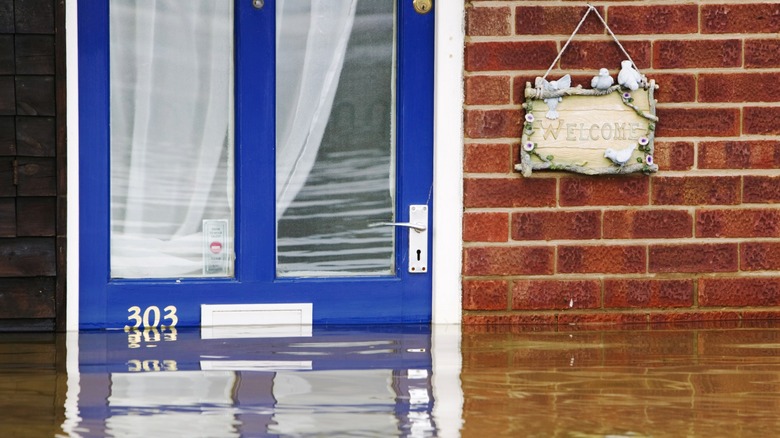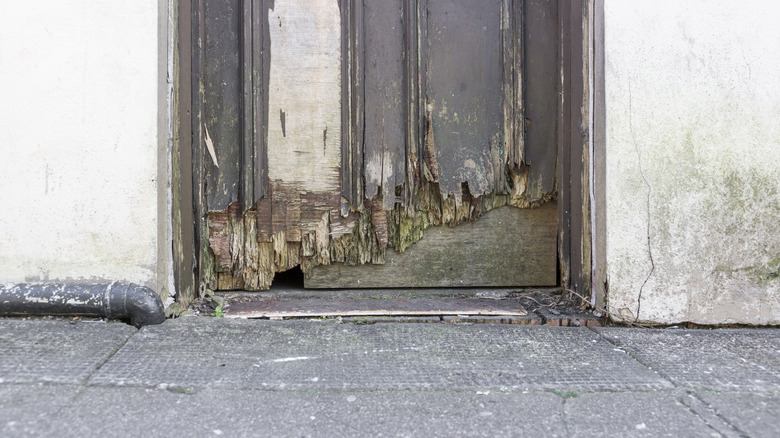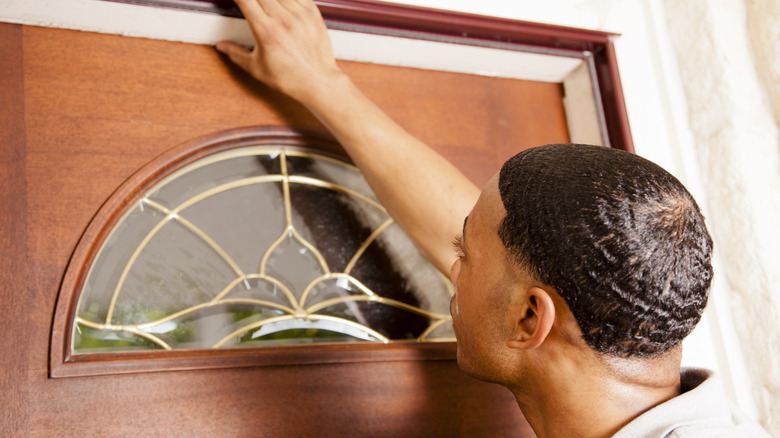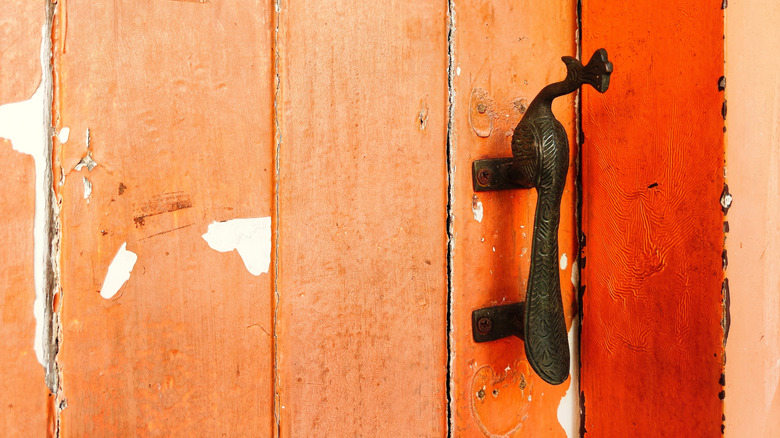Should You Fix Or Replace Your Water-Damaged Front Door? Here's What We Know
We may receive a commission on purchases made from links.
Do you know what homeowners claim the most from insurance companies? The first is property damage caused by wind and hail; the second is property damage caused by water. Make no mistake: repairing water damage can be quite costly. For perspective, you can easily find yourself paying up to $25,000 for damage caused by just an inch of water. Chances are, this is cash you'd rather spend on a reliable new car. You know what's worse? Insurance companies often don't cover gradual damage — the kind you don't notice until you spot some rot around the door. It shouldn't come as a surprise that front doors are particularly susceptible to water damage. They are easy targets for the elements, and It can be worse if they are not properly sealed.
How can you know that water is damaging your front door? Keep your eyes peeled for several signs, including yellowish splotches, warping, or cracks in the door panel. Now that you know what to look for, what should you do when you realize your door is on the receiving end of the world's most important liquid? Typically, homeowners get torn between replacing the front door entirely and fixing the damage. But which is best? Remember, replacing a water-damaged door can set you back up to $5,000. Therefore, unless the damage is extensive, it may be wise to opt for a simple repair. The trick, therefore, is to know what qualifies as extensive damage.
When to replace a water-damaged front door
What are some common signs that your front door is extensively damaged and, therefore, needs to be replaced? First, look out for dark, brownish streaks on your door. Although these colored spots can appear anywhere on the door, you should be worried if they are concentrated on the lower half or start from the bottom. Granted, you can try to resolve the issue by sanding or stripping. However, in most cases, this kind of damage means your front door is already rotten or about to start rotting. While there are several things you can do to keep wood from rotting — some of which are similar to the tips for preventing mold from entering your home — it's a different story when the rotting process has begun. Unfortunately, you have to remove the wood, and in this case, that means the entire front door.
A drafty door can be another red light. However, you'll need to first assess the damage. Sometimes, all you may need to do is replace the old weatherstripping with a new one. But if the door is warped so that a quick fix is not a solution, replacement is often advisable. Of course, this could also be the opportunity to install a fiberglass door or other modern equivalent, especially if the old door wasn't meeting minimum energy standards.
Other signs to replace your water-damaged front door
Another good sign to replace your front door is if it sticks so much that you have to apply more effort to open or close it. The truth is, a front door should always be closing smoothly. Several factors can cause a door to stick, including the accumulation of debris on the hinges. It can also be due to humidity issues. There are several ways to fix a sticking door. However, if the sticking has gone on for an extended period and is also made worse by warping, replacing the door is advisable. How about a cracked door? You can use putty to fill the cracks, then sand it well and add a coat of paint. Still, this quick fix may not work, especially if the crack is so extensive that the door seems ready to collapse.
Also, be on the lookout if you have wooden doors with glass panels, even if they typically look clean and sleek. For example, do you often notice mold on your front door? It could be because of the excessive moisture that settles on the glass panels, making the joint between the panels and wood susceptible to mold infestation. Remember, while glass is impermeable to water, it traps moisture and, therefore, is not entirely harmless. The other problem is condensation between glass panels, particularly for a double or triple-pane glass door. Typically, this means the insulated glass unit is leaky, a problem best solved by replacement.
When to repair and not replace a water-damaged front door
Here is the good news. In most cases, replacing a front door is not necessary. Most problems can be solved with simple fixes that don't take thousands of dollars. For instance, take the case of flaking paint. Moisture — including rain and condensation — is typically the most common cause of peeling and flaking. If it doesn't point to a more serious problem, including widespread rot, all you have to do is give a fresh coat of paint, taking necessary steps to ensure it sticks well. Make sure to thoroughly scrape the flakes before repainting so you're left with a smooth surface. Also, as we've already mentioned, you don't have to replace a sticking door. If it hasn't warped, you may need to trim the problematic edges, ensuring you leave a space of about 1/8 of an inch between the edge and the frame. You can use something like the Bosch 3-1/4 Inch 6.5 Amp Hand Planer to get the job done quickly and easily.
Other problems that a simple repair can fix include minor cracks, which you can solve by inserting a spline with wood glue, and drafts. To repair a drafty door, invest in a draft stopper (go for one that covers the full width of your door), stick on some weatherstripping tape, or even add an easy-to-install door curtain.



